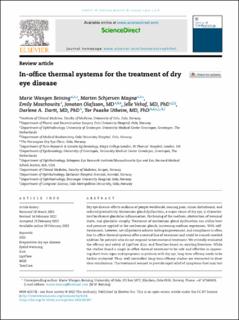| dc.contributor.author | Beining, Marie Wangen | |
| dc.contributor.author | Magnø, Morten Scherven | |
| dc.contributor.author | Moschowits, Emily | |
| dc.contributor.author | Olafsson, Jonatan | |
| dc.contributor.author | Vehof, Jelle | |
| dc.contributor.author | Dartt, Darlene Ann | |
| dc.contributor.author | Utheim, Tor Paaske | |
| dc.date.accessioned | 2022-09-19T08:04:16Z | |
| dc.date.available | 2022-09-19T08:04:16Z | |
| dc.date.created | 2022-05-04T20:39:57Z | |
| dc.date.issued | 2022-08-12 | |
| dc.identifier.citation | Survey of ophthalmology. 2022, 1-14. | en_US |
| dc.identifier.issn | 0039-6257 | |
| dc.identifier.issn | 1879-3304 | |
| dc.identifier.uri | https://hdl.handle.net/11250/3018733 | |
| dc.description.abstract | Dry eye disease affects millions of people worldwide, causing pain, vision disturbance, and reduced productivity. Meibomian gland dysfunction, a major cause of dry eye, is characterized by chronic glandular inflammation, thickening of the meibum, obstruction of terminal ducts, and glandular atrophy. Treatment of meibomian gland dysfunction can utilize heat and pressure applied to the meibomian glands, increasing meibum expression. With self-treatments, however, not all patients achieve lasting improvement, and compliance is often low. In-office thermal systems offer a second line of treatment and could be a much-needed addition for patients who do not respond to conventional treatment. We critically evaluated the efficacy and safety of LipiFlow, iLux, and TearCare based on existing literature. While the studies found a single in-office thermal treatment to be safe and effective in improving short-term signs and symptoms in patients with dry eye, long-term efficacy needs to be further evaluated. Thus, well-controlled, long-term efficacy studies are warranted to draw clear conclusions. The treatment seemed to provide rapid relief of symptoms that may last up to 1 year, but at a considerably higher cost than the at-home treatments. The choice of treatment depends on cost, compliance with at-home treatment, and personal preference. | en_US |
| dc.description.sponsorship | This research has been finded by the Department of Medical Biochemistry, Oslo University Hospital, Oslo, Norway (TPU) and the US National Institutes of Health Grants R01 EY029789 (DAD) and EY019470 (DAD). | en_US |
| dc.language.iso | eng | en_US |
| dc.publisher | Elsevier | en_US |
| dc.relation.ispartofseries | Survey of ophthalmology;Volume 67, Issue 5, September–October 2022 | |
| dc.rights | Navngivelse 4.0 Internasjonal | * |
| dc.rights.uri | http://creativecommons.org/licenses/by/4.0/deed.no | * |
| dc.subject | Dry eye diseases | en_US |
| dc.subject | Evaporative dry eye disease | en_US |
| dc.subject | Eyelid warming | en_US |
| dc.subject | iLux | en_US |
| dc.subject | LipiFlow | en_US |
| dc.subject | Meibomian gland dysfunction | en_US |
| dc.subject | TearCare | en_US |
| dc.title | In-office thermal systems for the treatment of dry eye disease | en_US |
| dc.type | Peer reviewed | en_US |
| dc.type | Journal article | en_US |
| dc.description.version | publishedVersion | en_US |
| dc.rights.holder | © 2022 The Author(s) | en_US |
| cristin.ispublished | true | |
| cristin.fulltext | original | |
| cristin.qualitycode | 1 | |
| dc.identifier.doi | https://doi.org/10.1016/j.survophthal.2022.02.007 | |
| dc.identifier.cristin | 2021575 | |
| dc.source.journal | Survey of ophthalmology | en_US |
| dc.source.volume | 67 | en_US |
| dc.source.issue | 5 | en_US |
| dc.source.pagenumber | 1405-1418 | en_US |
| dc.relation.project | US National Institutes of Health: EY029789 | en_US |
| dc.relation.project | US National Institutes of Health: EY019470 | en_US |

